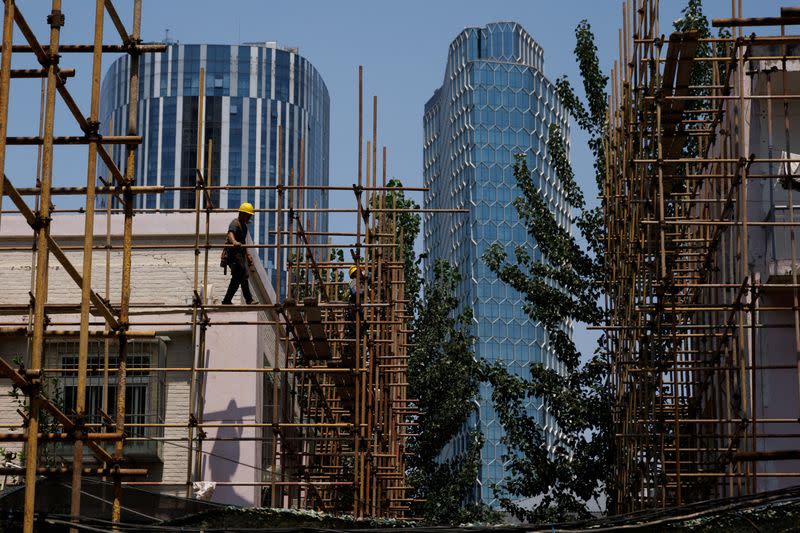China’s economic slowdown since the Covid-19 pandemic has raised significant doubts about the country’s future growth prospects.
After decades of stunning growth, analysts are watching whether Beijing is prepared take on more debt in 2024 or grow less.
The expectations were that once China ditched its draconian Covid rules, consumers would burst back into malls, foreign investment would resume, factories would rev up and land auctions and home sales stabilise.
Instead, Chinese shoppers are saving for rainy days, foreign firms pulled money out, manufacturers face waning demand from the West, local government finances wobbled, and property developers defaulted.
ALSO SEE: Freight Firms Avoid Red Sea, Hitting Asia-Europe Supply Chains
The dashed expectations have partly vindicated those who always doubted China’s growth model, with some economists even drawing parallels with Japan’s bubble before its “lost decades” of stagnation starting in the 1990s.
No long-term rejig map to clean up debt
China sceptics argue that Beijing failed to shift the economy from construction-led development to consumption-driven growth a decade ago, when it should have done so. Since then, debt has outpaced the economy, reaching levels that local governments and real estate firms now struggle to service.
Policymakers vowed this year to boost consumption, and reduce the economy’s reliance on property. Beijing is guiding banks to lend more to high-end manufacturing, away from real estate.
But a concrete long-term roadmap for cleaning up debt and restructuring the economy remains elusive.
Whatever choices China makes, it will have to account for an ageing and shrinking population, and a difficult geopolitical environment as the West grows wary of doing business with the world’s No-2 economy.
Many getting nothing from economic growth
China likely grew 5%-or-so in 2023, outrunning the global economy. However, beneath that headline is the fact China invests more than 40% of its output – twice as much as the United States – suggesting a significant portion of that is unproductive.
That means many Chinese don’t feel that growth. Youth unemployment topped 21% in June, the last set of figures before China controversially stopped reporting.
University graduates who studied for advanced-economy jobs are now taking up low-skilled positions to make ends meet while others have seen their wages cut.
In an economy where 70% of household wealth is parked in property, home owners are feeling poorer. Even in one of the few bright spots of the economy, the electric vehicle sector, a price war is causing pain downstream for suppliers and workers.
The national pessimism could present President Xi Jinping with social stability risks, analysts say. If China does slip into a Japan-style decline, it would do so before ever achieving the kind of development Japan did.
That would be felt widely as most global industries depend significantly on suppliers in China. Africa and Latin America count on China buying their commodities and financing their industrialisation.
Reform is difficult
China’s problems give it little time before it has to make some tough choices. Policymakers are keen to change the structure of the economy, but reform has always been difficult in China.
A push to boost welfare for hundreds of millions of rural migrant workers, who could – by some estimates – add 1.7% of GDP in household consumption if they had similar access to public services as urban residents, is already stalling due to worries about social stability and costs.
China’s efforts to resolve its property and debt problems come up against similar concerns.
Who pays for their bad investments? Banks, state-owned firms, the central government, businesses or households?
Any of those options could mean weaker future growth, economists say. For now, however, China appears hesitant to make choices that would sacrifice growth for reform.
Government advisers are calling for a growth target of around 5% for next year. While that’s in line with its 2023 target, it won’t have the same flattering year-on-year comparison with the slump caused by the 2022 lockdowns.
Such a target might push it into more debt – the type of fiscal looseness that prompted Moody’s to cut China’s credit rating outlook to negative this month, pushing Chinese stocks to five-year lows.
Where money gets spent will tell us if Beijing is changing its approach or doubling down a growth model many fear has run its course.
- Reuters with additional editing by Jim Pollard
ALSO SEE:
China Banks Pushed to Sell Bad Loans as Consumer Defaults Soar
Second Shadow Bank Rocked by China’s Property Crisis
Moody’s Downgrades China’s Credit Outlook to Negative
‘De-Risking’ by Western Businesses Eroding China’s Outlook
China Sees First-Ever Foreign Investment Deficit in July-Sept
China Asks Banks to Roll Over $13tn Local Debt at Lower Rates
























